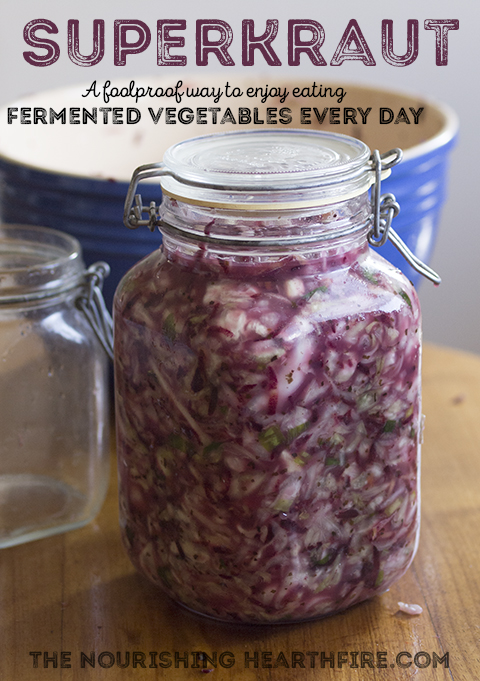
This kraut is super for a number of reasons:
- It tastes good enough to be eaten like a salad
- It has an added superfood ingredient that’s often missing from modern diets
- It is foolproof to make and to store, even for beginners, if you follow my detailed instructions
While these vegetables (especially fermented ones) are superfoods in their own right, I like to add iodine-rich sea vegetables to my ferments, to give added nutrition.
If you’re new to ferments, or have never successfully fermented before, or aren’t sure why I am recommending the ingredients and techniques that I do, I recommend you read my article 7 secrets to perfect sauerkraut every time.
Ingredients:
2 1/4 kgs cabbage (5 lbs)
450g carrots (1lb)
3 spring onions (green onions)
2 tablespoons wakame flakes, dulse flakes, or other dried sea vegetables (optional)
2 tablespoons Himalayan salt, Celtic sea salt, or other natural salt
1/4 cup whey, or 1/4 cup liquid from a successful batch of sauerkraut*
Equipment:
a large bowl (7 litres (7 quarts) is a good size)
2 litre Fido jar, or two 1 litre ones
Method:
First you’ll need clean hands, a clean bowl, clean chopping board, and a clean jar.
You’ll need vegetables that are nice and fresh, preferably organically grown.
Remove the tough outer leaves from the cabbage, cut it into quarters, then chop the cores out (weigh the cabbage before these are removed, not after). Usually I like to use a mix of red and green cabbage, but I couldn’t get red cabbage for the batch in the photo so I used purple carrots instead of orange to add purple goodness to the kraut.
Finely shred the cabbage with a knife (or with the mandoline attachment in a food processor). Peel and grate the carrots, finely chop the onions. Place all the vegetables in a bowl with the dulse flakes, salt and whey.
Use your hands to combine all the ingredients, squeezing them as you go, until everything is evenly mixed in. Taste a bit of the cabbage to see if you like the taste. It should be well-salted and pleasant to eat, not so highly salted that it’s inedible, and not so low in salt that it seems lacking in seasoning. Use your taste buds as a guide. Continue to squeeze and mix, to help release the juices in the vegetables and soften them. Depending on your frame of mind this can either be a pleasant meditative task, or it can be something you quickly rush through…either way will get the job done and create a good kraut.
When the mixing and squeezing is done, take handfuls of the kraut and press it into the jar. Keep adding layers and squashing them down with your hand, packing it into the jar really well, and you should have a good amount of liquid on top of the kraut. If you have extra kraut, you can put it in smaller jar.
I like to fill the jar almost to the top, exposing it to as little oxygen as possible. This sometimes means that it will leak a little during fermentation, so make sure to put a dish underneath the jar to catch this if you don’t want it to make a mess.
If there isn’t enough liquid in the mixture for it to be liquid at the top of the kraut, first try using your hand to push the kraut down further into the jar, to release any remaining juice, and if that doesn’t work, make a brine by mixing 1/4 teaspoon of salt into 1/2 cup of water and add some of this over the top. I like to add a splash of whey to the brine as well.
For the best taste, leave the jar to sit at room temperature for at least 3 to 4 weeks, preferably more than 6 weeks. I usually start eating this after around a week of fermenting, and keep the jar in the kitchen, eating some every day until it’s all gone. You could also make larger batches of this kraut and store it a lot longer. Try to keep it in a fairly cool and stable climate, but not in a fridge.
*You can try making this ferment without any whey or kraut juice if you want. I’ve successfully fermented without these things before, but find that I have more reliable results and a longer keeping time with whey or kraut juice. If you don’t have any whey on hand and would like some, take unsweetened yoghurt (the only ingredients should be milk and cultures) and strain it through a couple of layers of cheesecloth, the whey will drain from the yoghurt and you can use it in this recipe.
Nice!
LikeLike